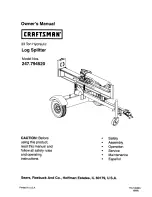
14
J. Transport
Log Splitter is equipped with two 10” diameter Wheels to make it easier to move around.
If you would like to move your log splitter to different locations, secure the unit during transport to prevent damage
or injury.
Always tighten the bleed screw to prevent oil spill
K. Maintenance
WARNING!
Before performing any maintenance be sure that:
Log splitter is disconnected from power source.
Pusher plate is fully retracted
Oil has cooled
Before each Use
Inspect hydraulic fluid level (see page 9)
Inspect log ram, vertical beam, and guides
Grease using #2 Lithium Grease
Inspect/Sharpen Splitting wedge (see page 13)
Inspect/Tighten Nuts, Bolts, and Hardware
Visually Inspect All welds
Check Alignment of moving parts and for damaged or worn parts
Inspect Electrical Cord
Inspect Extension Cord (when applicable)
After Each Use
Clean/Lubricate
Every 100 Hours of Operation
Replace Hydraulic Oil (see page 12)
L. Troubleshooting
Problem
–
Log Fails to Split
Possible Cause
o
Incorrect Positioning of Log
Reposition Log
Problem
–
Log Fails to Split
Possible Cause
o
Log exceeds permitted dimensions or the wood is too hard for the capacity of the
machine
Reduce log Size
Problem
–
Log Fails to Split
Possible Cause
o
Wedge has burs, nicks, or flat spots and needs to be sharpened
Sharpen the splitting wedge (see page 12)
Problem
–
Log Fails to Split
Possible Cause
o
Oil Level is Low
Check and Adjust Hydraulic Fluid Oil Level (see page 9)
Problem
–
Log Fails to Split
Possible Cause
o
Leak of Hydraulic Oil Hydraulic Pressure is too low
Place a piece of cardboard under the log splitter to locate the leak. Worn
components should be replaced.























